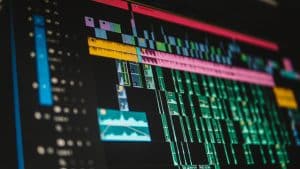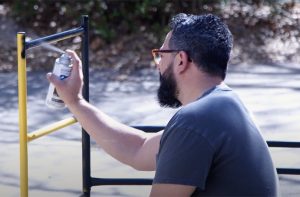Anyone who’s scoured the web for videos and audio to use in their project will know that there is a myriad of words, phrases, and legal jargon surrounding stock footage and similar resources. These can be difficult to get your head around, especially when you’re trying to figure out usage and licensing conditions. This terminology comes under three main categories: Copyright and the Public Domain, Types of Footage, and Usage. We’ve put together a handy little glossary of the most useful terms and phrases in each category for all the different kinds of work out there to try and make things that little bit easier for you!
Copyright and the Public Domain

Copyright
At its most basic, copyright is an exclusive right (a right which, when held by an individual or individuals, cannot be held by others) granted to the creator(s) or author(s) of a work to determine if and how their work can be used by others. It relates to certain kinds of intellectual property, usually in tangible form.
Examples of where copyright applies are: Written works, including computer programs and online writing; Pictorial works, including graphs, diagrams, graphics and sculpture; Movies, sound recordings and other audiovisual works; Musical works, including lyrics; Pantomime and choreography, where recorded; Architectural works.
Copyright is not all-encompassing however. Some copying or redistribution of copyrighted works are permitted through ‘Fair Use‘ doctrines (see below). There are also types of work which cannot be copyrighted.
Examples where copyright does not apply are: Mere lists of items or contents (as opposed to method or instructions attached to these lists); Titles, names and slogans (which are subject to Trademarks instead); Works which are common property, such as calendars, tape-measures, etc.; Works in the public domain (see below).
Whether or not copyright is in effect for intellectual property can be a bit of a minefield, and can also vary from country to country. However, U.S. Copyright law provides a few basic tenets for the length of time a work remains under copyright:
- Literary, dramatic or musical works: The duration of the author or creator’s lifetime, and an additional 70 years. In cases of more than one author, the lifetime of the longest-surviving author or creator is applied.
- Sound Recordings: 50 years after the work was first created, or 70 years after the work was first released.
- Films: 70 years after the death of the longest-surviving principal director or composer.
- All works published in the United States before January 1, 1923 are in the public domain.
All Rights Reserved
“All rights reserved” is a copyright phrase which, though jurisdictionally obsolete, is still commonly used to indicate that all the rights granted under copyright are held by the creator(s) or author(s) of the work in question. The copyright symbol serves a similar function, as does the symbol in the case of sound recordings. The copyright symbol is not required to reserve the rights of works published after March 1, 1989, but its presence or absence is significant in works published before this date.
Public Domain
“The public domain” is an umbrella term for all creative works to which no exclusive intellectual property rights (i.e. copyright) apply, because they have been waived, have expired, or because they are not applicable. Works may also appear in the public domain by virtue of having been created before copyright existed, or because intellectual property rights have been forfeited. Other names for the public domain include ‘commons‘ or ‘the public sphere‘, and is often signposted by the phrase “No Rights Reserved.”
Creative Commons

Creative Commons is a type of copyright license, developed by a non-profit organisation of the same name. In simple terms, it allows for a middle-ground between Copyright (“all rights reserved”) and Public Domain (“No rights reserved”). CC licenses operate on a “some rights reserved” basis and last for the duration of a work’s copyright. This allows the creator(s) or author(s) of a work or works to offer certain usage rights to the public, while reserving others, before the expiration of copyright. At Videvo, we license some of our clips under Creative Commons 3.0, (CC-BY).

Videvo Attribution
Our own in-house license allows for the non-exclusive use of materials free of charge, for perpetuity, but you must provide a credit to the original author of the clip. You may not redistribute the clip(s) in their original form on other platforms or services, for example, torrent websites or other stock agencies. You can read more about the ways we license our footage here.
Royalty-Free
Royalty-free is a type of copyright license that gives users non-exclusive rights to an image, illustration, video, sound effect, or type of music based on a one-time payment or agreement with the original creator(s) or author(s) or copyright owner. Under royalty-free licensing, individuals can use these products in multiple projects without having to purchase additional licenses.
Open Access
Open Access is an alternative publishing model that refers to materials – usually the products of research – which are available online without price and permission barriers. These outputs are often licensed under Creative Commons in order to encourage redistribution in order to promote research impact.
Public Access
Like open access, public access refers to materials freely available online. However, it pertains specifically to government-funded research publications. This is often applied to footage filmed by NASA, and other similar organisations.
Types of Footage

Stock Footage
Stock footage – also known as stock video or b-roll – comprises (usually short) excepts of footage inserted into a wider video project, but not shot specifically for that project. This can include footage purposefully created with its multiple applications in mind (i.e. shots that fit a broad variety of concepts, styles or aesthetics), archival footage, public domain footage, or even outtakes from other projects.
Archival Footage
Quite simply, archival or archive footage refers to video content sourced from film archives or libraries, often put together by an organisation or institution. More often than not, archived footage depicts historical or cultural events, and may therefore have originally been intended for other purposes (such as editorial or news uses, or cultural uses, such as entertainment or advertising). Use of this footage in other projects is what makes it ‘stock footage’ and similarly, stock footage can also be archived. Videos in this category are often in the public domain.
![]()
Historical Footage
The definition of historical footage depends on when you think the past ends and the present begins. Mostly used as a synonym for ‘archival footage‘, ‘historical footage’ is mostly used to describe older footage, which often depicts historical and cultural events. As above, videos in this category are often in the public domain.
Found Footage
Found footage is a filmmaking term for footage used in a video project which was originally created for another purpose, such as archival or historical footage.
Usage
Fair Use
Fair use is a term applied to uses of copyrighted material which can be undertaken without seeking permission from the copyright holder. The purpose of this use, or copying, is understood to be limited, and/or transformative, and in the interests of freedom of expression.
Broadly speaking, this falls under two categories: commentary and criticism or parody and pastiche. Four factors are required for evaluating the validity of fair use:
- The purpose and character of the use (including its commercial/not-for-profit/educational purpose)
- The nature of the copyrighted work.
- The amount and substantiality of the portion used, in relation to the copyrighted work as a whole
- The effect of the use on the potential market or value of the copyrighted work.
Editorial Use
A publishing term that comes under ‘Fair Use‘ policies, editorial use limits the applications of intellectual property, as well as depictions of copyrighted work, trademarks, or recognisable persons for informative, not-for-profit uses only. Here is our detailed rundown of how you can use footage marked for ‘editorial use only’.
With these words locked down, finding the right stock footage for your project should be easier than ever. After all, the perfect clip is no good if licensing or copyright restrictions mean you can’t use it!





